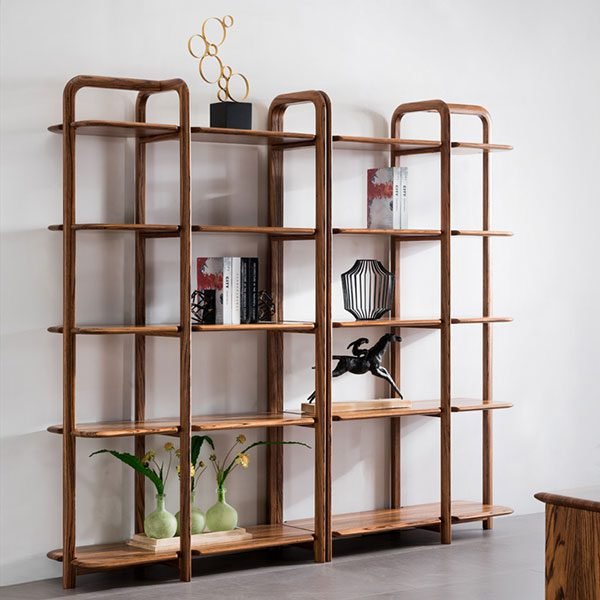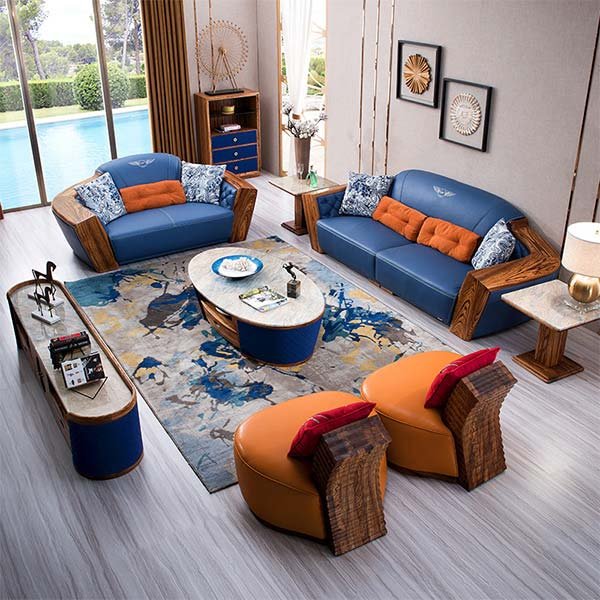“Bringing nature indoors, wooden furniture harmonizes with biophilic design.”
Benefits of incorporating wooden furniture in biophilic design
Wooden furniture has long been a popular choice for interior design due to its timeless appeal and versatility. However, beyond its aesthetic qualities, wooden furniture also aligns perfectly with the principles of biophilic design. Biophilic design is an approach that seeks to incorporate elements of nature into the built environment, promoting a sense of connection with the natural world. In this article, we will explore the benefits of incorporating wooden furniture in biophilic design.
One of the key principles of biophilic design is the use of natural materials. Wooden furniture fits this criterion perfectly, as it is made from a renewable resource and has a warm, organic feel. Unlike synthetic materials, wood has a natural beauty that cannot be replicated. Its unique grain patterns and textures add visual interest to any space, creating a sense of harmony and tranquility.
In addition to its aesthetic appeal, wooden furniture also has a positive impact on our well-being. Research has shown that exposure to natural materials, such as wood, can reduce stress levels and improve overall mood. The natural scent of wood has a calming effect on the mind, promoting relaxation and a sense of comfort. By incorporating wooden furniture into biophilic design, we can create spaces that promote mental and emotional well-being.
Another benefit of wooden furniture in biophilic design is its durability and longevity. Unlike many synthetic materials, wood is known for its strength and resilience. High-quality wooden furniture can last for generations, reducing the need for frequent replacements and minimizing waste. This not only benefits the environment but also saves money in the long run.
Wooden furniture also has the ability to improve indoor air quality. Unlike synthetic materials that can release harmful chemicals into the air, wood is a natural material that does not emit any toxic substances. In fact, wood has the ability to absorb and store carbon dioxide, helping to reduce greenhouse gas emissions. By choosing wooden furniture, we can create healthier indoor environments for ourselves and future generations.
Furthermore, wooden furniture is highly versatile and can be used in a variety of design styles. Whether you prefer a rustic, traditional, or modern aesthetic, there is a wooden furniture piece that can complement your desired look. Its neutral tones and timeless appeal make it a versatile choice that can easily adapt to changing design trends.
In conclusion, incorporating wooden furniture in biophilic design offers numerous benefits. From its natural beauty and calming effect to its durability and positive impact on indoor air quality, wooden furniture aligns perfectly with the principles of biophilic design. By choosing wooden furniture, we can create spaces that promote well-being, sustainability, and a strong connection with nature. So, whether you are designing a home, office, or public space, consider the many advantages of incorporating wooden furniture into your biophilic design.
Examples of wooden furniture that enhance biophilic design principles
Wooden furniture has long been a popular choice for interior design due to its timeless appeal and natural beauty. However, beyond its aesthetic qualities, wooden furniture also aligns perfectly with the principles of biophilic design. Biophilic design is an approach that seeks to incorporate elements of nature into the built environment, promoting a sense of connection with the natural world. In this article, we will explore some examples of wooden furniture that enhance biophilic design principles.
One example of wooden furniture that enhances biophilic design principles is the use of live edge tables. Live edge tables are made from slabs of wood that retain the natural edge of the tree, showcasing the unique patterns and textures of the wood. This type of furniture brings a touch of nature into the space, creating a sense of warmth and organic beauty. The natural imperfections and irregularities of the wood add character and authenticity to the design, reminding us of the inherent beauty of the natural world.
Another example of wooden furniture that aligns with biophilic design principles is the incorporation of reclaimed wood. Reclaimed wood is salvaged from old buildings, barns, or other sources, giving it a rich history and unique character. By using reclaimed wood in furniture design, we not only reduce waste but also bring a sense of history and connection to the space. The weathered textures and aged patina of reclaimed wood create a sense of authenticity and timelessness, evoking a feeling of being in harmony with nature.
In addition to live edge tables and reclaimed wood, wooden furniture can also incorporate elements of nature through its design. For example, furniture with organic shapes and curves mimics the forms found in nature, creating a sense of harmony and balance. The use of natural finishes, such as beeswax or linseed oil, enhances the natural beauty of the wood while also promoting a healthier indoor environment.
Furthermore, wooden furniture can be designed to incorporate living elements, such as plants or moss. For instance, a coffee table with a built-in planter allows for the integration of greenery into the design, bringing the benefits of nature indoors. This not only adds visual interest but also improves air quality and promotes a sense of well-being.
In conclusion, wooden furniture is an excellent choice for incorporating biophilic design principles into interior spaces. Whether it’s through the use of live edge tables, reclaimed wood, organic shapes, or the integration of living elements, wooden furniture brings a sense of nature and connection to the built environment. Its natural beauty, warmth, and authenticity create a welcoming and harmonious space that promotes well-being and a deeper connection with the natural world. So, if you’re looking to enhance your interior design with biophilic principles, consider incorporating wooden furniture into your space.
Tips for integrating wooden furniture into a biophilic design space
Wooden furniture has long been a popular choice for interior design due to its timeless appeal and versatility. However, it is not just its aesthetic qualities that make wooden furniture a great addition to any space. In fact, wooden furniture aligns perfectly with the principles of biophilic design, which seeks to incorporate elements of nature into the built environment. In this article, we will explore the benefits of integrating wooden furniture into a biophilic design space and provide some tips on how to do so effectively.
One of the key principles of biophilic design is the use of natural materials, and wood is a prime example of this. Wood brings a sense of warmth and organic beauty to a space, creating a connection to nature that is essential for our well-being. By incorporating wooden furniture into a biophilic design space, you can create a harmonious and inviting environment that promotes relaxation and reduces stress.
When choosing wooden furniture for a biophilic design space, it is important to consider the type of wood used. Opt for sustainably sourced wood, such as reclaimed or FSC-certified wood, to ensure that your furniture has minimal impact on the environment. Additionally, choose furniture with a natural finish that allows the grain and texture of the wood to shine through. This will enhance the natural beauty of the material and create a more authentic connection to nature.
In addition to its aesthetic appeal, wooden furniture also has practical benefits that make it an ideal choice for a biophilic design space. Wood is a durable and long-lasting material, making it a wise investment for furniture that will stand the test of time. It is also easy to maintain and can be refinished or repaired if necessary, ensuring that your furniture remains in top condition for years to come.
Another advantage of wooden furniture is its versatility. Wood can be crafted into a wide range of styles and designs, making it suitable for any type of biophilic design space. Whether you prefer a rustic, farmhouse-inspired look or a sleek, modern aesthetic, there is a wooden furniture piece that will complement your design vision. Additionally, wood can be stained or painted in various colors, allowing you to customize your furniture to suit your personal style.
When integrating wooden furniture into a biophilic design space, it is important to consider the overall layout and arrangement of the furniture. Create a sense of flow and connection by arranging the furniture in a way that mimics the natural environment. For example, place a wooden dining table near a large window to create a seamless transition between indoor and outdoor spaces. Incorporate natural elements, such as plants or water features, alongside the wooden furniture to further enhance the biophilic design concept.
In conclusion, wooden furniture is a perfect fit for a biophilic design space due to its natural beauty, durability, and versatility. By incorporating wooden furniture into your design, you can create a space that promotes well-being and connection to nature. Remember to choose sustainably sourced wood and consider the overall layout and arrangement of the furniture to create a harmonious and inviting environment. With these tips in mind, you can successfully integrate wooden furniture into your biophilic design space and enjoy the benefits it brings.
Заключение
Wooden furniture aligns with the principles of biophilic design by incorporating natural elements into interior spaces. The use of wood brings a sense of warmth, texture, and organic beauty, creating a connection to nature. It also promotes a calming and soothing environment, enhancing well-being and reducing stress. Additionally, wooden furniture is sustainable and environmentally friendly, contributing to a healthier and more eco-conscious design approach. Overall, incorporating wooden furniture in interior design aligns with the principles of biophilic design, creating spaces that are visually appealing, emotionally satisfying, and supportive of human health and well-being.



